I don't think I had been to the West End before, and it was a real eye opener. It seemed that at least half the people on the streets were in uniform, and they were from everywhere! Americans predominated, but there were shoulder flashes from all over Europe and tne Empire. Bomb damage was less severe than in the City, and it was all happening!
Staff losses and recruitment
Reference to Edward Pawley's book "50 years of
BBC Engineering" shows that this was indeed the case. In the April of
1944 Engineering Division was suddenly faced with the prospect of having
to release 250-300 juniors to the forces by the end of June. So, a case
of being in the right place at the right time!
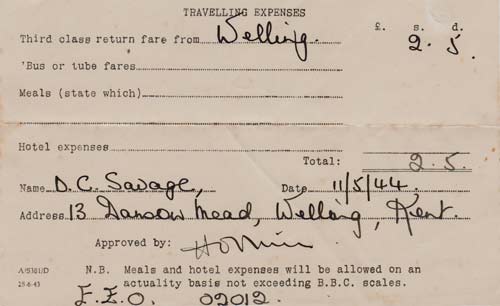
After the interview in Bentink House, I was accepted as a Yit (Youth in Training ) on £l-7-6 per week, plus 8/6 cost of living-bonus, in a brown envelope, to be collected and signed for on Thursdays from the Cash Office in Bank Buildings (above Barclays Bank), and instructed to report to the Head of Lines Department (HLD) Harry Rantzen (father of Esther) in Brock House, on 22nd. May 1944 (15 days before D-day). In practice this meant making onesself known to his secretary Mrs. Peters who, was quite the most formidable woman I met during my career in the BBC (and the BBC probably had more than its fair share of this species!).

Broadcasting House in 1944.
Charlie Field was in charge of what could be considered as the operational section of Lines Dept., responsible for the provision and maintenance of the lines carrying programmes and control circuits between studios and transmitters (the S.B. Network), links for outside broadcasts, and inter-office communications, both telephonic and telegraphic. He turned out to be quite a reasonable boss. I discovered that my duties would be split between manning the fault log in the first-floor office, and maintaining a range of equipment in the Tcst Room, located in Room LG25, just below pavement level on the western side of the
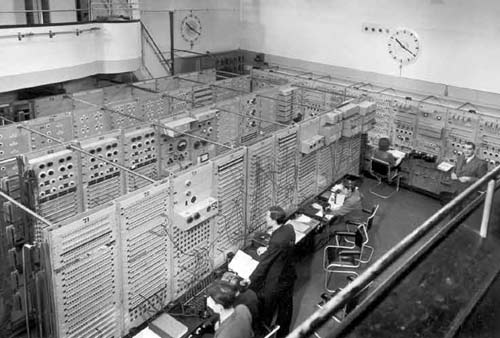
London Control Room.
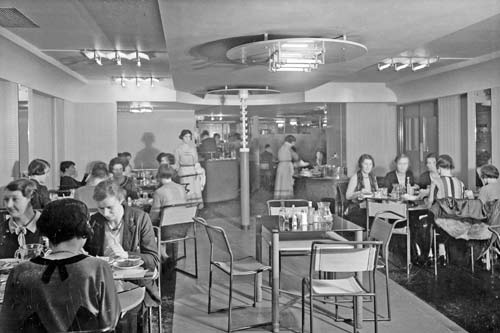
A pre-war photograph of the Broadcasting House
basement canteen. During the war a kiosk bar was erected in place of the
centre column.
If memory serves, we normally worked until 6.30pm, or 10.00pm if scheduled for fault logging duty, but one could finish at six if one was attending an evening class at the Regent Street Poly. The evenings were of course lighter in those Summer days since the country was operating on DBST. There was also a rota for Saturday afternoon and Sunday fault logging. An hour was allocated for lunch, but one could spend much of this time in the long queue which stretched along the corridor leading to the Basement canteen. This facility, in co-operation with the concert hall lounge, offered a 24/7 service, and during the evening a small kiosk located near the canteen cash desk would be opened up to provide a tiny bar.
LG25 also housed terminal equipment for a number of communication circuits such as the 4-channel v.f, telegraph systems to Caversham, Aldenham and Wood Norton. There were rows of telegraph relays which had to be cleaned and adjusted regularly, and the terminal of the notoriously unreliable Glasgow teleprinter phantom which was carried on 600lb. overhead conductors. Adjacent to LG25 was LG26, a small technical stores (for things like ACSP3 and AL60 valves which seemed to have a rather short lifespan). This room also doubled as a sleeping space for the Duty Lines Engineer. Adjacent again was LG27 which also served as a test room. Round the corner from LG27 was the Ericson PABX, full of Strowger switches and uniselectors, which was maintained by a wild Irishman know to all as Fitz. Next to LG25 in the other direction was LG24 which housed Harry Day and a couple of other Mechanic/Wiremen who could turn their hand to any construction/repair job that needed doing in order to maintain the service. LGs 24,25 and 26 extended out under the pavement and were protected by a temporary "bomb buster" constructed along the outside of the building.
Much of the work carried-out in LG25 was connected with outside broadcasts. There were the portable equaliser-repeaters, PER2AS and PER3s, with their associated crated HT and LT batteries. Among the duties we shared were the maintenance and charging of these glass-cased accumulators in a small room in the basement of Egton House. As well as maintaining the repeater sets one had sometimes to transport these heavy brass-bound teak objects to London rail termini by taxi and then, having found the correct train, "give them and their associated battery boxes into charge of the Guard", passing a suitable tip into his gnarled hand in order that he would remember to put them off at the required station.
I only got to operate a repeater for real on one occasion. That was for a Saturday evening relay from Welling's Embassy Ballroom. On arriving at the darkened Bexleyheath Telephone Exchange I had to knock-up the attendant, find the previously installed PER3, behind a bay, connect the HT and LT batteries, ring Ken Lake at the Embassy on the Tele F, and check that everything was in order. The broadcast was successful and as I walked home I visualised Ken attending the after-show party.
The other aspect of OBs was the testing and equalising of temporary circuits into BH. Either Ken Lake (an ex video camera-man from pre-war Alexandra Palace) or "Old Rootham" (who was well past retirement age) would set out to the broadcast site armed with an oscillator PTS 10 (an early design of the young Neville Watson, then stationed in Birmingham/Manchester), and a field telephone. If/when he managed to establish contact one would carry-out DC tests with a Bridge Megger, and then "squeak" the circuit, using an Amp. Det., in order to be able to plot out its amplitude/frequency characteristic. Having done this one tried for a best fit with an equaliser mask, and from this determined the equaliser settings which would be required to be set for the broadcast. For most of the local London venues this seemed to be nothing more complex the a "fifty ohm shunt". Finally the noise was measured by means of a Test Programme Meter (TPM), plus "ear-holing" on a loudspeaker.
A bonus when working in LG25 was access to a line feed of the American Forces Network (AFN) which originated from 80 Portland Place and was not then receivable in Welling. This was something quite different, with Sergeant Dick Dudley's "Duffle Bag" record request programme at mid-morning, and Sergeant George Monahan's "Strictly on the Record" in the late afternoon.
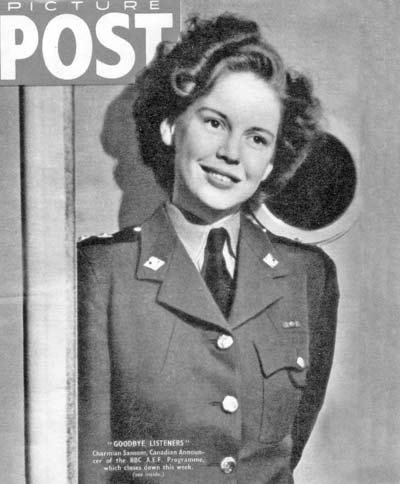
CWAC Lt. Charmian Sansom.
On a tour of the Control Room I got to sit in one of the three Continuity Suites, which were glassed-in cubicles, each providing separated spaces for a continuity announcer and a programme engineer, inserted under the balcony, and equipped with, I think, the ubiquitous OBA/8s. I remember thinking that the AFN pfc. continuity announcer on duty at that time in the AEFP Purple Con. looked no older than me, but then nearly all the AFN staff were little more than teenagers. On the right hand side, as one entered the Control Room was the Senior Maintenance Engineer's (SME) desk, whilst on the other side was the small glass windowed office of the Senior Control Room Engineer (SCRE). He being the engineer responsible for the minute by minute operation of the whole of the BBC's contribution and distribution network in the UK.
On D-day a tiny room leading off the balcony was equipped for direct communication with the beach-head mobile transmitter due to be landed a few days later in Normandy.
Soon after D-day the V1 flying bombs started to arrive and live relays of the chimes of Big Ben were replaced by recordings, in order to eliminate the risk of the sound of explosions being used by the enemy as a targeting aid. Flying bombs were no problem if one was working in LG25 or below, but the first-floor office, being on an outside wall, was different. Red lights and buzzers were installed in all the vulnerable offices, and when a chap stationed on the roof spotted a bomb coming BH-wards the alarm would be sounded. We would then move across the passage into a small test room to await the extinguishing of the red light. This refuge was shared with the occupants of the War Reporting Office, which was located next door, among whom on a couple of occasions we had the company of Richard Dimbleby. Some staff slept on the floor of the Concert Hall at night, since this was probably among the safest areas in the building.
The V1s did not do much for the ease of commuting. Southern Railway trains would be diverted around circuitous routes to by-pass damage, and the Bakerloo Line would be shut down whenever the threat was considered serious enough to shut the watertight doors on the under-Thames section.
In the June and July evenings people sleeping in the tube stations left barely enough room on the platforms for passengers to wait. Walking was often quickest, and I remember coming up Regent Street in the mornings when there would be queues of GIs outside the Rolls Razor shop waiting for it to open.
On the evening of 20th. June I went to my first proper symphony orchestra concert at the Albert Hall, and "Prommed" for I think 2/6d. No queuing. It was quite an interesting experience with the red warning lights going on and off during the performance, but nobody taking any notice, even though they were all standing/sitting under a giant glass dome! This was only eight days before the concerts were evacuated to the Bedford Corn Exchange, which they shared with a similarly evacuated American Band of the AEAF led by Glen Miller, and only three or four weeks before the death of Sir Henry Wood.
On 31st. July I was promoted to Probationary Technical Assistant (PTA) on £2-5-0 plus cost of living bonus. On 21st. August I was sent on a four-week basic theory course (the A Course) at the Hamilton Shashke academy located in Maida Vale Studios. I suppose there were around fifty students in attendance. The seating plan placed me between Charles Gunn-Russel and a Jill Corvine-Richie, both just down from Oxbridge, whereas I was just up from Woolwich Poly! The fourth member of our little group was a Maureen something-something.

A V1 descending.
I got back to BH on 18th September, (by which time the V2 rockets were beginning to take over from the V1s), and nine days later I was sent off again, to Cambridge, (where they hardly new what a bomb was!), together with an old school friend Nobby Clarke, who had been transferred to Lines from London Control Room around the August of 1944, and Johny Dewis, who I think had been invalided out of the forces and was something of an intellectual, (he got Nobby and me to spend a long evening

Creed 7B Teleprinter.
The 7B was quite an electro-mechanical box of tricks, but we were told that by the end of the course we would be able to take a jumbled set of basic components, assemble them into a printer, adjust it and set it to work, without access to the hand-book. And the surprising thing was that when the time came, we found we could! An abilitv which was to come in handy in the REME some three years later. The other members of the course were PO trainees and a group of RAF personnel. The school operated the PO system whereby one signed-in on arrival in the morning, and at the start time a line was drawn across the page to separate the sheep from the late coming goats.
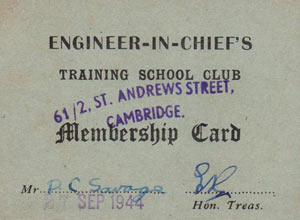
I returned to the real world just in time to say farewell to colleague Ted Howland who was off down the mines as a Bevin Boy. He had been largely responsible for the telegraphy side of the business, and I found myself moved in as his replacement. The main part of the job involved the maintenance and overhaul of the BH inter-regional teleprinters, and operational maintenance of the Caversham Broadcast system located in B27, a room to which I got more or less

Corridor leading to the Control Room Balcony. The
door on the right is the entrance to Room B27.
The BH internal network teleprinters were at that time located in Room 240. There were around nine permanently connected positions plus a Telex. This latter was I suppose a precursor to the e-mail. The operator just dialled a number, checked the answer-back, and then sent the message. If a satisfactory answer-back was obtained at the end she could be pretty certain that the message was there at the destination in hard copy, which is more than can be said for the present system! The operators in 240 were a wider social mix than one would expect to find today. This was probably a result of the direction-of-labour statutes then in place. Operating a teleprinter was better than operating a lathe! They were watched over by another dragon lady, the supervisor Miss Carter, who kept a beady eye on them and on any PTA who was trying to sort out problems in her area. The most dreaded problem was a report of a "sticky keyboard". This was not easy to solve, although one could always squirt a little oil in one or two places. Sometimes it was probably just that the operator was a bit bored and wanted a break and/or someone different to talk to!
Oxford and Woodeaton
Indicative of the amount of war material stored
in the country was that even after D-day one could see from the Oxford
train fields full of Sherman tanks and others filled with coils of barbed
wire stacked some ten feet high.
The weekly pay packets used to be brought up to London from Woodeaton by a lady driver in a large Packard (straight eight?) wooden bodied shooting brake. There must have been quite a lot of money in that vehicle, but no problems with security in those days, although she did claim to have been machine gunned from the air on one occasion!
The weekly pay packets used to be brought up to London from Woodeaton by a lady driver in a large Packard (straight eight?) wooden bodied shooting brake. There must have been quite a lot of money in that vehicle, but no problems with security in those days, although she did claim to have been machine gunned from the air on one occasion!
In November I was promoted to TA2, something definite at last! About this time an NBC war correspondent (Ed Haaker or sometimes Bjorn Bjornson) took to dropping in to B27 mid-morning to check for the latest news on the agency printers operating therein, and to pass the time of day, before doing a live insert into what I suppose was a US east coast breakfast news programme. I remember that Bjorn was very proud of a watch, marked to show periods of a baseball game, which he had been given by American troops when had been stationed in Iceland.
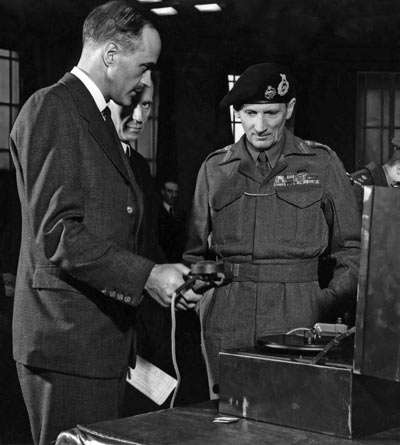
Field Marshal Montgomery and Harold Bishop (Controller
Engineering) in Broadcasting House in 1944, inspecting a portable disc
recorder which had been designed for use by BBC War Correspondents in
war zones
May brought VE-day. I was volunteered to come in, but not a lot of work was done. In the early evening Regent Street was effectively pedestrianised by the crowds and Piccadilly Circus was packed solid, with a Liberator bomber flying overhead firing off coloured flares. As I made my way home I reflected that it had been a fairly eventful, but on the whole successful first year.

Related page
I acquired a lapel badge like this soon after I joined. They were regarded as bling with no official function. I was issued with a simple black and white pass bearing no photo. One colleague said that he could get in by skilful handling of the back of a ten cigarette pack!

